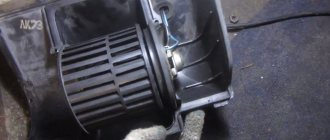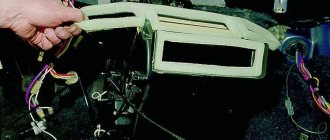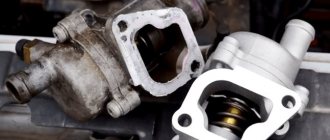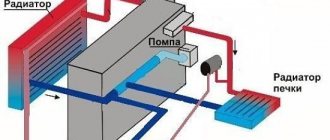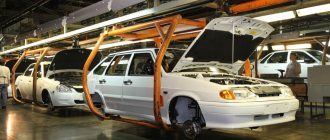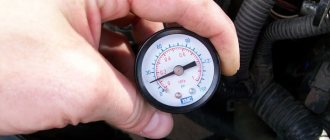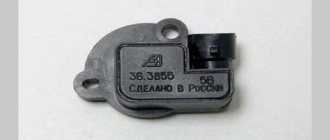Cold heater at idle rpm may be due to the following reasons - low coolant level in the expansion tank, the formation of an air lock in the engine and/or heater cooling system, faulty water pump, clogged radiator and some others. In most cases, the car owner can independently get rid of the problem when the heater blows cold at idle. To do this, you will need to check the cooling system, or rather the operation of some of its elements.
If the stove works, but does not heat (cold air blows)
First of all, it is important to understand the basic operation of most car heaters.
There are exceptions, but heaters that use water-cooled engines use very hot coolant to warm the interior of the car. This is accomplished by running antifreeze through a special component called a heater rod, which is similar in design and functionality to a small radiator. When the fan motor draws air through this heat exchanger, this air enters and heats the interior of the car.
If cold air blows from the heater deflectors, even when the car is warm enough, there may be several reasons:
- low coolant level;
- blockage in the heater line;
- the heater dampers do not work;
- heater valve stuck;
- Electronic problem: bad switch or broken wires.
After the car has been turned off, some time has passed and the pressure in the cooling system has dropped, you can start by checking the coolant level. If the antifreeze level is low, then this may be the cause of the furnace stopping working - the hot antifreeze simply does not circulate sufficiently through the heat exchanger to receive heat from the furnace, and therefore cold air is blowing from the latter.
Filling the coolant may solve the problem, however, a low coolant level itself often indicates another problem - leaking through a gasket or hose, or in the worst case, even burning coolant in the combustion chambers of the engine.
If the check shows that the antifreeze level is normal, then you can start the engine again and let it warm up, and then check the temperature along the coolant flow line where the main heater hoses enter the main heater housing. The safest way to do this is to use a non-contact infrared thermometer called a pyrometer. If all the main hoses are within the same temperature as the vast majority of the coolant line, but one of the hoses is cold, then there is likely a blockage in the heater coil
If the vehicle uses a valve in one of its heater hoses, it is also important to check the operation of that valve. If the valve is jammed, then the reason for the non-working stove most likely lies in it
Stove valve malfunction
All cars use a valve that shuts off the flow of coolant through the heater radiator. It is he who is controlled by the “heat - cold” switch on the center console in the cabin. For various reasons, the faucet may not open all the way. In this case, the stove does not heat up at idle speed, since not enough hot antifreeze enters the radiator.
The solution is simple - the faucet must be replaced. We advise you to choose high-quality spare parts, since cheap taps quickly fail and jam in the closed or open position.
Why doesn't the stove heat well?
There are several known reasons indicating that the stove heats well only at high speeds:
- There is air in the heating system. The stove does not function normally when air gets in when replacing antifreeze. It can also get into the heating system if the integrity of the cylinder head is damaged.
- The heater radiator is clogged. There are several reasons why the heater radiator is clogged inside and outside. From the outside, it gets clogged through the protective casing, as a result of which dust, leaves, insects, etc. get into the stove radiator. The inside of the radiator becomes clogged exclusively during operation with various dirt and deposits that are present in the engine cooling system, as well as due to the use of low-quality antifreeze.
- Thermostat is faulty. The thermostat in your car may become stuck open and closed. Moreover, if the stove heats well only at high speeds, but poorly at low speeds, most likely the reason is that it is jammed in the open position.
- Fan failure. The function of a fan in a car is to pump air into the cabin; if it works poorly due to failure of the bearings or graphite brushes, unstable operation of the heating in the cabin and the entire ventilation system will occur. Also, the cause of fan failure may be a problem in the electrical power circuit.
- Heater valve malfunctions. As a rule, such malfunctions occur only in car heaters of domestic brands: the rubber bands may dry out, the valve lever may wear out during operation or become sour.
- The cabin filter is clogged. Severe contamination of the filter is the reason why the car only heats up while driving. It should be replaced once a year.
- Damage to the stove control unit. This malfunction also causes trouble for owners of domestically produced cars. Malfunctions in the operation of the control unit can be caused by a breakdown of the air temperature sensor.
These are not all the reasons that affect the operation of the car’s heating system, but these are the ones that most often arise among motorists.
Airlock
The problem is due to a faulty conservator cap and insufficient coolant level. Factors affect the cooling system, in which excess air accumulates, creating an air lock. Due to insufficient circulation at low speeds, the stove blows cold. The air heats up when the speed increases, and when stopped it cools down again. What to do? Eliminate the root cause: as in the case of system depressurization, add antifreeze, replace the expansion tank cap, bleed the system, blowing out excess air. You can remove the air by standing on an overpass so that the front wheels are higher than the rear wheels. Open the expander cover. At this moment, the air will come out accompanied by a characteristic sound (“gurgling”). Coolant will also leak, so it is important to top it up to the required level. After this procedure, it is likely that after a while the air lock will form again. This is due to a blown cylinder head gasket. But in this case, the stove does not work well not only at idle.
Damper repair or replacement
It happens that the damper is “stuck” - that is, it stops turning due to the fact that the fastenings have oxidized and have not been looked at for a long time.
In the VAZ 2110, you can only “get close” to the damper from under the hood. First you need to remove the deflectors, then bend the antennae. Now try to move the flap by hand.
https://youtube.com/watch?v=2Ci9giL3p88
If it works and “walks” easily, then the reason is something else. But in any case, knowledgeable car enthusiasts recommend replacing the plastic damper with an aluminum one.
This small modification allows for better heat retention, the stove will work better, since, plus, there will be no deformation, which plastic dampers are prone to.
Preventing the operation of the stove in the car
In order for the stove in your car to heat well and not let you down at the most inopportune moment, you need to follow a few simple tips.
- Keep the radiator clean. Light contamination from the outside of the radiator can be removed with a vacuum cleaner. Flushing the engine cooling system, with which the heater radiator is inextricably linked, will help get rid of internal deposits and blockages in the channels.
- Use good antifreeze. High-quality antifreeze is the key to long-term operation of not only the stove in the car, but also the engine. Remember this and do not forget to replace it in a timely manner.
- Change the cabin filter more often. A clogged cabin filter will certainly create problems not only for the operation of the stove, but also for the air conditioning and cabin ventilation system as a whole. In addition, dust and pollen deposited in the filter can pose a serious health hazard (especially for allergy sufferers).
If, at an outside temperature of minus 25 °C, your car’s heater heats the interior to +16 °C from below and up to +10 °C from above, then it can be considered quite serviceable. To avoid problems, it is recommended to carry out preventive measures in a timely and responsible manner that will allow you to enjoy a comfortable ride in a well-warmed-up car.
And remember, the longer the service life of the machine, the more attention its heating system requires. This applies to all cars, regardless of country and manufacturer
Failure of the cylinder head gasket
You need to understand that damage to the cylinder head gasket leads to mixing of oil with antifreeze or exhaust gases entering the cooling system. Usually the problem is quickly diagnosed by obvious signs. But some drivers note that minimal burnout of the gasket may be accompanied by the appearance of excess air in the cooling system.
The only solution may be to replace the cylinder head gasket, but we advise you to take your time and check all other factors first. This is an expensive procedure and a rare problem, so save it for last.
Sensor that measures the temperature in the cabin
It is located in the ceiling of the Lada Kalina, close to the lighting lamp and perceives the temperature regime of the atmosphere inside the cabin. The element can also affect the operating mode of the stove. This occurs by comparing the actual temperature with the parameters set by the driver on the dashboard. Thus, the electronics adjusts the position of the dampers based on the “scanned” situation, and it seems to the driver that the stove has stopped responding to his “requests”. The reason for the disagreement is usually the banal oxidation of the contact group of the sensor, due to which it ceases to function correctly. The solution to the problem is to clean the contacts or replace the component.
Clogged radiator
Over time, scale forms in the radiator, which creates plugs. The obstruction of the lines leads to a decrease in the pressure that supplies warm air. At high speeds there may be an increase, but at idle you won’t get any warmth. What to do? Theoretically, you can try flushing the radiator yourself. Many auto stores offer special mixtures that destroy salt compounds. But purging and flushing will only work if the lines are not completely clogged. If there is no circulation in one of the pipes, then it will not be possible to flush it. Replacement only. Advice may also include checking the thermostat, replacing the filter (if available), and the gasket. But in practice, the stove does not heat up at idle in 90% of cases precisely because of the high wear of the radiator. To avoid such problems, it is recommended to take preventive measures in time. Use a high-quality cooling mixture, change it regularly, monitor the quality (after draining, for any impurities), do not mix several models of antifreeze. Operate your car competently and enjoy a warm car in winter.
Faulty pump
There are often explanations online that the stove only works while moving due to a poorly pumping pump. This statement is only partly correct. At idle, the rotation speed of the pump is low and, accordingly, the circulation of coolant is small. Low heat transfer results in low supply air temperature, which increases with increasing pump performance. More revolutions means the air heats up more.
What to do? Any problems associated with a malfunction of the pump (poor pumping, leaking, acting up, etc.) can be solved by replacing it. No one can give a 100% guarantee, because even with a fully operational pump, there is a possibility that the problem of cold air at idle will remain.
Why does the heater blow cold at idle?
The essence of the reason why a cold heater at idle in most cases comes down to problems with the engine cooling system. So, there are FIVE main reasons for this situation and several less common ones:
Insufficient coolant level in the system. This is the most common and easiest option to fix. In such a situation, even significantly heated coolant is not able to sufficiently warm up the interior heater
Please note that a low level of antifreeze in the engine cooling system not only causes the heater to blow cold air at idle, but also harms the engine itself, as overheating occurs, which leads to a decrease in its overall life. This problem is an indicator of the failure of its individual parts, or a change in their geometry.
Formation of air jams
Air in the cooling system may appear due to depressurization of individual pipes or their connection points, improper replacement of coolant, malfunction of the air valve, problems with the pump, or a breakdown of the cylinder head gasket. Air locks impede the circulation of antifreeze in the system; as a result, the stove heats only when moving, and at idle cold air blows from the deflectors.
Faulty water pump. This unit is responsible for circulating fluid through the system and when the impeller is not able to create sufficient flow, the heater blows cold air at idle, and when the car is moving it can be a little warmer.
Dirty heater radiator. The heater radiator tends to become clogged over time. As a result, heated liquid begins to pass through its honeycomb poorly. And this, in turn, will lead to the fact that the stove fan drives barely warm, or even completely cold, air.
The coolant supply is cut off. If the stove has a valve for supplying fluid to the heater radiator, then it may be that the car owner simply forgot to open it, having closed it in the summer, or it is jammed in a half-open or completely closed state. This is especially true for domestic cars, especially quite old ones (for example, VAZ “classic”, Moskvich and other cars of Soviet design). Typically, taps simply rust, especially when, instead of factory-made antifreeze, the car owner uses ordinary water as a coolant, especially “hard” water, that is, which contains a significant amount of salts of various metals.
Thermostat failure. When the thermostat rod sticks in the open state, this will be the reason why the heater blows cold at idle. If in a cold engine the coolant initially circulates in a large circle, it will only be able to warm up after the car has been driving for a long time, or it will take a lot of time to warm up when the engine is idling.
Problems with the operation of the climate control system. Modern cars equipped with this system sometimes experience software malfunctions, which leads to a situation where the heater does not heat up at idle. Problems may be associated with either incorrect configuration of a particular system, or a software or hardware failure of the climate control.
Troubleshooting methods
Methods for eliminating the problem of why the stove blows cold air at idle will depend on the reasons themselves, which have been rechecked in order. So, first of all, you need to check the coolant level in the expansion tank. Please note that this must be done on a cold engine (!!!) so that the coolant is also relatively cold and the car owner does not get burned.
If it is below the middle, then add coolant. In this case, it is necessary to take into account the compatibility of antifreeze. It is advisable to fill it with the same brand and class that is in the cooling system. If the antifreeze has not been changed for a long time and/or is in poor condition, then it is better to replace it with a new one.
If air pockets form in the cooling system, they must be removed. There are three main methods for removing air from the cooling line. They all boil down to allowing the engine to run with the system depressurized so that the air can come out of the system on its own during the antifreeze circulation process. You can perform the procedure for removing air from the cooling system yourself in the garage or even in the field.
When the check shows that the pump is faulty, it will have to be replaced accordingly. But to identify the problem, you will have to dismantle the water pump. Often the cause of failure lies in wear of the impeller, bearing, or depressurization of seals. As for the bearing and rubber seals, in some cases they are replaced with new elements.
If the reason lies in the difficulty of the passage of liquid through the heater radiator, then you can try to rinse it. At the same time, it will be possible to see if it has cracked the body, and, accordingly, if antifreeze is flowing through it and if air is being sucked in. Typically, flushing has a positive effect on the efficiency of the heater, including at idle speed of the engine, as well as when the car is driving on the highway or in the city driving cycle at high speeds.
If the car heater has a valve for supplying liquid to the radiator, then do not forget to check its operation. So, for example, on VAZs (both new and old), this is one of the weak points of the interior heating system.
When the stove heats poorly only when starting on a cold engine and the engine itself does not reach operating temperature for a long time, then the first thing you should do is check the operation of the thermostat. So, for the first few minutes, until the coolant reaches an operating temperature of about +80°C...+90°C, the pipe leading to the top of the main radiator will be cold and relatively soft. The thermostat valve should only open when the antifreeze is warm enough. If yours is different, the thermostat must be replaced. In rare cases, you can try to repair it, but it is better to install a new one.
The car's climate control system operates on the basis of its own separate software and hardware. Therefore, checking its operation depends on the specific brand of car and the type of system itself. The verification algorithm is usually described in the car manual. If such information is available, you can check it yourself. Otherwise, it is better to seek help from a car service center, preferably one that specializes in working with the specific brand of car being tested.
Conclusion
If the stove heats only when moving, first of all you need to check the level of antifreeze in the cooling system, as well as its condition. Next, you need to check the pump, thermostat, radiator, heater valve, and the presence of air pockets in the system.
If, when the engine warms up at idle, the heater blows cold for too long, then it makes sense to insulate the radiator grille with improvised or special means. In any case, remember that a poorly functioning stove in any case indicates problems in the engine cooling system, and operating a car with similar problems is fraught with costly repairs in the future, so repair work must be carried out as quickly as possible.
FAQ:
- Kalina's stove doesn't heat well at idle
- Skoda Octavia heater does not blow at idle
- Audi A6 heater blows cold at idle
The design of the heating system of the VAZ-2110
The concept of interior heating on the VAZ-2110 remains the same - the air supplied to the cabin is heated by the cooling system. To do this, a radiator is installed in the cabin, under the front panel, which is included in the cooling system; heated antifreeze moves through it. The air passing through the radiator is supplied through the air intake. After heating, the air flow through the air ducts is supplied to the necessary areas - the windshield, legs, torso.
Forced air circulation is provided, which increases the efficiency of the distribution of warm flow throughout the cabin. For this purpose, the stove is equipped with a fan driven by an electric motor.
The air heating temperature is regulated by dampers. One of them allows the flow either through the radiator (for heating) or bypassing it. The damper divides the flow to obtain the desired temperature - one part of it goes through the radiator, and the second bypasses it, after which it is mixed, the degree of heating is regulated and supplied to the air ducts.
The second damper is designed to shut off the air supply to the cabin from the outside. Thanks to it, a closed air circulation mode is established.
Clogged pipes and heater radiator
During the operation of the car, dirt accumulates in the pipes and the radiator itself. This may occur due to the use of low-quality coolant or its untimely replacement. As a result, circulation in the system deteriorates, which is why there will be no heat at idle.
The way out of the situation is to flush the entire cooling system. It is necessary to drain the antifreeze, add distilled water, adding a small amount of citric acid. There are also special cleaning products. We recommend washing in several stages. In very difficult cases, it is better to replace the stove radiator.
Advice from auto mechanics
To tune the VAZ heating system, its circuit diagram is studied. The system can be modified to block the air flow to the rear of the car using foam. The factory thermostat is also being replaced with an analogue one with 6 holes. In this case, the temperature in the cabin will remain longer, and the stove will heat better. Another way to modify the standard 2110 heating system is to install a plug for the deflector.
If your car has air conditioning, it should only be turned on in wet weather. In winter, the stove turns on and directs the air onto your feet or onto the glass.
To ensure good operation of the heater, the nozzle is raised above the lining. Before starting the stove in winter, it is recommended to clean the glass from moisture.
Problems with the cooling system
When the heater on a VAZ-2114 does not work, reasons other than electrical may lie in the coolant circulation system:
- Airlock. As the coolant cools, air accumulates in the upper part of the radiator. Subsequently, air enters the thermostat and a large circle of coolant movement is blocked. The heater core remains cold. There are many ways to fix the problem. But the easiest thing is to squeeze out excess air from the system. To do this, unscrew the cap from the tank. With the engine running, the cold hose is intensely compressed, causing air to escape into the reservoir. If this method does not work, you will have to disconnect the hose to remove the air lock.
- Radiator. Few people devote time to maintaining their car, and especially the heating system. The internal space becomes clogged with dirt, which impedes the flow of coolant. The outer multi-cellular surface becomes clogged with dust and foreign objects, which interferes with heat transfer. In this case, only cleaning the radiator and replacing the cabin filter will help.
- Water pump. Wear of intake blades leads to a decrease in productivity and, consequently, a drop in pressure. Reduced idle pressure is unable to supply heated coolant to the radiator. Only high engine speeds allow you to create the necessary pressure.
- Low coolant level. An antifreeze level below the minimum provokes airing of pipelines. You just need to add antifreeze to the maximum level.
- Cylinder head gasket. A gradual decrease in coolant level, intense white smoke from the exhaust system and the smell of gasoline (oil) in the tank indicate a burnt-out gasket. Through the gap that appears, antifreeze enters the cylinders and into the crankcase with oil. Replacing the gasket requires removing a large number of parts.
- Thermostat. The operating principle of the thermostat is based on the property of a certain metal to change its original shape when the temperature rises. If the element fails, the coolant moves in a small circle without entering the heater radiator. In this case, only replacing the thermostat will help.
- Faucet. It regulates the flow of coolant, that is, the temperature inside the car. If it breaks, the fluid flow stops. Although it is held on by two screws, it is installed in a hard-to-reach place, under the dashboard, which is associated with certain difficulties.
- Hoses. Connecting rubber hoses become unusable after prolonged use. They crack and break. Through the formed cracks, the system depressurizes, and consequently, antifreeze leaks, air gets inside, etc.
Causes of malfunctions
In winter, when the cabin heater stops working, you feel discomfort: it is cold in the car and the windows freeze. To figure out why the stove on the VAZ-2114 does not work, the car should be driven into the garage.
Additionally, we recommend reading the article by our specialist, which describes how the on-board computer of the VAZ-2114 works.
Before starting work, you need to become familiar with the structure of the vehicle's heating system. The structure consists of the following elements:
- heater radiator;
- pipes supplying heated coolant;
- faucet that regulates the flow of liquid;
- interior dampers directing the air flow;
- a fan that creates air flow;
- fan speed controller;
- a pump that creates a flow of heated liquid;
- thermostat, which is responsible for the direction of movement of the coolant.
When all these elements function normally, the car interior is warm. But when one of them stops working, interruptions in heating occur.
If the fan of the VAZ-2114 heater does not work, the reasons most often given by auto mechanics are the following:
- fan failure;
- fuse blown;
- lack of contact in the electrical circuit;
- heater radiator malfunction;
- The thermostat does not respond to temperature changes;
- faucet breakdown;
- low pressure in the coolant circulation system;
- airlock;
- The engine cylinder head gasket was blown.
We recommend: How to change the oil filter without changing the oil?
We also recommend reading our expert’s article, which talks about how to change the heater radiator on a VAZ-2110.
Heating system design
The VAZ 2110's interior heating system has its own differences. First of all, it should be noted that the system works separately.
It is represented directly by the heater - a stove that prepares warm air entering the cabin through pipes - heat distributors. Air ducts lead into the cabin, where hot air flows directly from the control panel, and also blows on the windows or is directed to the driver and passenger's feet.
Control parts and air ducts of the VAZ 2110 stove
All this is controlled by a unit for regulating the air flow and its temperature (heating), that is, an air distributor. The VAZ 2110 stove has one more difference from others - it has an evaporator.
Replacing the cable
Quite often, car owners manage to improve the operation of the heater by replacing the cable that is responsible for controlling the heater damper. After replacing or tightening the stretched cable, the stove in the VAZ-2109 begins to function normally, and warm air begins to blow both into the interior and onto the car windows, which is especially important in inclement weather. It is recommended to replace or tighten the cable in the following sequence:
- if a visual inspection indicates that the cable cannot be used in the future due to obvious damage, it must be replaced as quickly as possible;
- if this element is simply stretched, then you can tighten it with a regular screwdriver by making a couple of turns clockwise;
- Finding the cable is quite simple; it is located on the heater body, near the gas pedal.
A correctly adjusted length of the cable, which you can learn from the training video tutorial on the Internet resource, will help keep the damper in the desired position, which, in turn, will close the resulting gap and the interior will begin to be heated by a warm air flow.
Causes of poor-quality stove operation
Based on the complex structure of the stove, it becomes clear that it may not work correctly for many reasons. A malfunction of at least one of the components and components of the heating system can lead to a malfunction of the stove. In this case, a malfunction may occur due to the driver’s fault, or it may be a consequence of aging or incorrect operation of other vehicle systems.
Problems with the stove can manifest themselves in the following ways:
- Poor interior heating.
- Cold air from the stove.
- Variable temperature of air supplied from the stove.
- Weak flow of hot air from the stove.
- The heater in the car does not turn on.
Knowledge of the structure of the stove itself and possible breakdowns will make it possible to avoid large expenses when repairing a car. Let's look at the most common causes of poor-quality stove operation below.
Fan doesn't work
A fan malfunction can often be one of the problems with heating the interior. The cause of this failure is usually damage to the bearings or graphite brushes, which may require complete fan replacement. Also, the fan may be faulty due to the blown fuse or relay in the electrical power circuit, which is also a reason to contact a car service center.
If the fan makes a whistle during operation, and its rotation speed changes from minimum to maximum and vice versa, then the cause of the problem may be a failure of the fan motor. In such conditions, the radiator may remain hot, but it will not be possible to warm the interior to the desired degree.
Insufficient coolant level
A malfunction of the stove can be caused by a coolant leak, as a result of which heat stops flowing into the cabin radiator in the required volume. This in turn leads to a decrease in the volume of antifreeze in the expansion tank. To fix the problem, you need to find the location of the leak, add antifreeze to the expansion tank, and sometimes it may be necessary to replace the coolant supply valve.
Engine pump faulty
The pump is used to circulate antifreeze and to ensure proper functioning of the stove. If such a pump breaks down, a malfunction may occur in many engine components, including the vehicle interior heating device.
A malfunction of this part can be caused by wear on the inside of the impeller, a broken crankshaft belt, or even jamming of the pump itself. It is better to eliminate this kind of problem by completely replacing the pump, and to avoid such breakdowns, it is recommended to regularly check the hose leading to the pump, and also listen to sounds under the hood.
Blown engine head gasket
The head gasket is designed to connect the block and the car engine head itself, ensuring tightness and preventing coolant and fuel from mixing with each other. Burnout of the gasket in the engine cooling jacket leads to the generation of exhaust gases, which can enter the cooling system through the pipes. In this case, the heat exchanger becomes airy and the efficiency of its operation decreases, the coolant can heat up, and malfunctions are observed in the operation of the stove.
Thermostat malfunction
The thermostat is a device directly involved in the circulation of coolant, so its malfunction will affect the air temperature in the cabin. Since the thermostat can be in an open or closed position, its failure is characterized by jamming in one of these positions.
If the thermostat is stuck in the closed position while driving in city traffic, the temperature of the antifreeze may increase, and subsequently the engine may overheat. When stuck open, the interior temperature will be low when driving in high gears, while the temperature will remain normal at low speeds.
Heater core blockage
The heater radiator can become clogged for various reasons, and this can happen both from the outside and from the inside. For example, the outside of the radiator may become clogged due to dust, leaves, and insects entering through the protective casing. On the inside, clogging occurs due to dirt and deposits that can form in the engine cooling system.
Cabin filter clogged
A heavily contaminated cabin filter is one of the common causes of stove malfunctions. Many drivers treat it quite dismissively and do not replace or throw away the old one for a long time.
It should be remembered that a clogged filter is an obstacle to the flow of heated air into the cabin. In addition, when the filter is clogged, dust and mold spores can enter the cabin and accumulate in the filter itself.
How to flush a car heater radiator
You can flush the heater radiator either on the car or with removal. At the same time, removing such a radiator is often difficult. For this reason, at the initial stage, you can try to flush the entire cooling system with special ready-made compounds. If this does not help, then the radiator needs to be removed.
After removal, it is possible to flush the radiator both outside and inside. External cleaning allows the heat exchanger to ventilate and generate heat. For internal cleaning you will need:
- powerful pressure of hot water;
- a set of cleaning products, compositions or solutions;
Flush the radiator by applying cleaner and water inside under low pressure. Please note that it is better to use special ready-made cleaning compounds. It is important to make sure in advance that the product is suitable for a particular radiator and the material it is made of. The reason is that radiators are made from different materials.
We also recommend reading the article on how to install an additional car heater pump. From this article you will learn how to make the stove radiator work more efficiently, as well as how to install an additional pump on the stove.
As a result, the use of, for example, acids, caustic soda, alkalis or caustic solvents can damage rubber and plastic parts, as well as the radiators themselves made of copper, aluminum, etc. Also, preparing cleaning solutions at home is associated with a high risk of injury, chemical burns or poisoning.
The stove doesn't blow at all, what's the problem?
If the heater fails, you can do the initial fault diagnosis yourself.
Unfortunately, the complex heater control system has not proven itself as a device that allows you to take the hassle off the driver and automatically maintain the set temperature. Instead, we got a lot of trouble and cold interiors in the frost. Let's go from simple to complex and first let's look at the problems with the electric heater motor. Everything is more or less simple here:
- Fuse. We turn on the stove, it doesn’t work. If we were lucky, the fuse had blown. Finding it is as easy as shelling pears, it is more difficult to find out the reason for its burnout. The 25-amp fuse F18 is located in the main mounting block; it also protects the circuit for the glove compartment lighting, heated rear window and is partially related to the cigarette lighter, so it is easy to diagnose its failure. And in order to find the short circuit that caused it to burn out, you will have to call all these circuits - the glove compartment light, the rear window heating, the headlight washer and the cigarette lighter.
Heater fuse location.
- Contacts. A very common occurrence on the VAZ 2110 is the lack of contact on the heater control unit or on the electric motor itself, there is no contact on the power wire on the automatic control system. You will have to go through and clean all these contacts.
We check the contacts on the heater control unit and the electric motor.
- Stove blower. The electric motor of the stove also does not last forever and can either simply burn out or fail for another reason. To check its operation, we get to its power supply contacts and measure the voltage. If we record 12 V at the engine input, the problem is in the engine. The brushes may be worn out or burnt, the motor commutator may have burned out, or the winding may have burned out or shorted out. In any case, no one will bother with it, we’ll just replace the electric motor with a new one.
Checking the automatic heater control system
The stove control system can also give out surprises. They consist in the fact that one of the speeds may not work, several, or only one, the most powerful, may work. At the same time, the SAUO block is not universal and is selected depending on the year of manufacture of the car:
One of the reasons for the failure of the stove may be the unit of the automatic heater control system.
- 2110-8128020-03, price 2300 rubles, used in the last ten years of production;
- 21102-8121020, price 3100 rubles, installed on cars with air conditioning;
- 2110-8128020-02, about 2 thousand, set for the first ten years of production;
- 2110-8128020-01, 1840 rubles, used on some cars before the year 2000.
